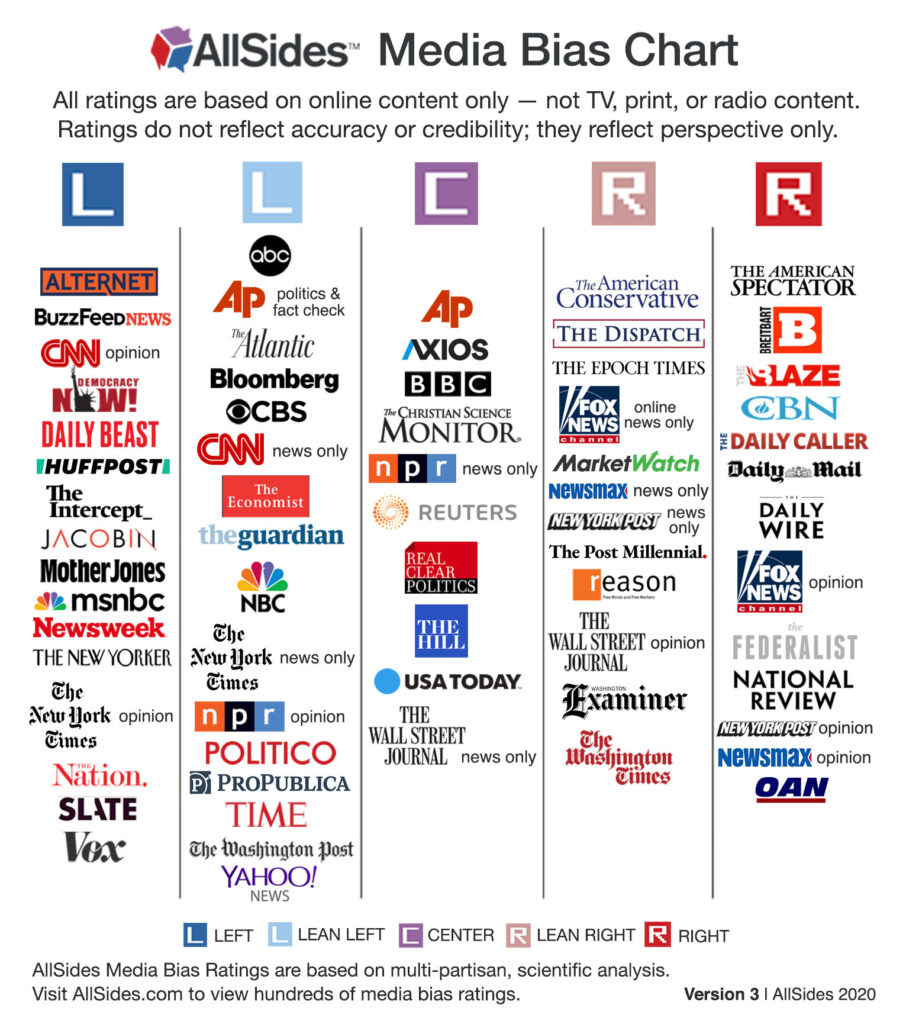Media Bias
Where does your news source fall on the spectrum?
How To Identify Fake or Biased News
How to Spot Fake News
by Eugene Kiely and Lori Robertson
FactCheck.org® A Project of The Annenberg Public Policy Center, posted Nov 18, 2016
Key Characteristics of Bogusness —
An anonymous author; excessive exclamation points, capital letters and misspellings; entreaties that “This is NOT a hoax!” and links to sourcing that does not support or completely contradicts the claims being made.
How to spot a fake:
Consider the source. In recent months, we’ve fact-checked fake news from abcnews.com.co (not the actual URL for ABC News), WTOE 5 News (whose “about” page says it’s “a fantasy news website”), and the Boston Tribune (whose “contact us” page lists only a Gmail address). Earlier this year, we debunked the claim that the Obamas were buying a vacation home in Dubai, a made-up missive that came from WhatDoesItMean.com, which describes itself as “One of the Top Ranked Websites in the World for New World Order, Conspiracy Theories and Alternative News” and further says on its site that most of what it publishes is fiction.
Read beyond the headline. If a provocative headline drew your attention, read a little further before you decide to pass along the shocking information. Even in legitimate news stories, the headline doesn’t always tell the whole story. But fake news, particularly efforts to be satirical, can include several revealing signs in the text. So please read the entire story.
Check the author. Another tell-tale sign of a fake story is often the byline. Google the author to verify the claims.
What’s the support? Many times these bogus stories will cite official — or official-sounding — sources, but once you look into it, the source doesn’t back up the claim. For instance, the Boston Tribune site wrongly claimed that President Obama’s mother-in-law was going to get a lifetime government pension for having babysat her granddaughters in the White House, citing “the Civil Service Retirement Act” and providing a link. But the link to a government benefits website doesn’t support the claim at all.
Check the date. Some false stories aren’t completely fake, but rather distortions of real events. These mendacious claims can take a legitimate news story and twist what it says — or even claim that something that happened long ago is related to current events.
Satire? Is this a joke? Andy Borowitz has written a satire column for the New Yorker and many people do not get his jokes. And then there are the more debatable forms of satire, designed to pull one over on the reader. Paul Horner a hoaxer makes a living off his posts. Asked why his material gets so many views, Horner responded, “They just keep passing stuff around. Nobody fact-checks anything anymore.”
Check your biases. We know this is difficult. Confirmation bias leads people to put more stock in information that confirms their beliefs and discount information that doesn’t. But the next time you’re automatically appalled at some Facebook post concerning, say, a politician you oppose, take a moment to check it out.
Use your common sense: If the story sounds improbable, it often is. Use your common sense before you click and share.
Consult the experts: FactCheck.org, Snopes.com, the Washington Post Fact Checker and PolitiFact.com. It’s likely at least one has already fact-checked the latest viral claim to pop up in your news feed.

